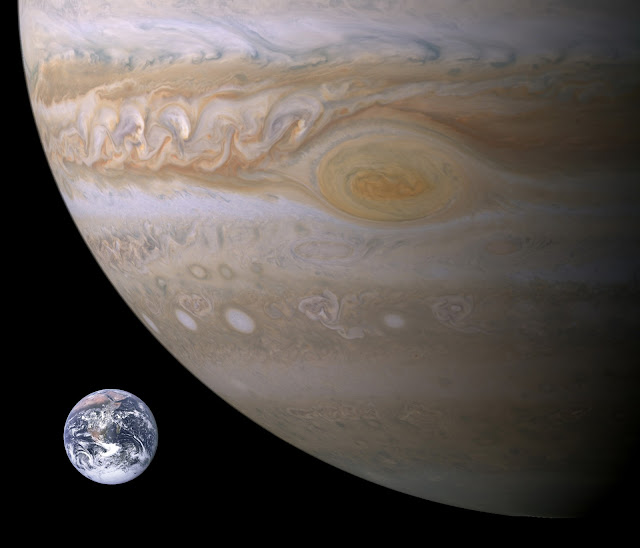The Earth
Earth is the third planet from the Sun, the densest planet in the Solar System, the largest of the Solar System's four terrestrial planets, and the only astronomical object known to harbor life.
According to evidence from radiometric dating and other sources, Earth was formed about 4.54 billion years ago. Earth gravitationally interacts with other objects in space, especially the Sun and the Moon. During one orbit around the Sun, Earth rotates about its own axis 366.26 times, creating 365.26 solar days or one sidereal year. Earth's axis of rotation is tilted 23.4° away from the perpendicular of its orbital plane, producing seasonal variations on the planet's surface with a period of one tropical year (365.24 solar days). The Moon is Earth's only permanent natural satellite. Its gravitational interaction with Earth causes ocean tides, stabilizes the orientation of Earth's rotational axis, and gradually slows Earth's rotational rate.
Earth's lithosphere is divided into several rigid tectonic plates that migrate across the surface over periods of many millions of years. 71% of Earth's surface is covered with water, with the remainder consisting of continents and islands that together have many lakes and other sources of water that contribute to the hydrosphere. Earth's polar regions are mostly covered with ice, including the Antarctic ice sheet and the sea ice of the Arctic ice pack. Earth's interior remains active with a solid iron inner core, a liquid outer core that generates the magnetic field, and a convecting mantle that drives plate tectonics.
Within its first billion years, life appeared in Earth's oceans and began to affect its atmosphere and surface, promoting the proliferation of aerobic as well as anaerobic organisms. Since then, the combination of Earth's distance from the Sun, its physical properties and its geological history have allowed life to thrive and evolve. The earliest undisputed life on Earth arose at least 3.5 billion years ago. Earlier physical evidence of life includes biogenic graphite in 3.7 billion-year-old metasedimentary rocks discovered in southwestern Greenland, as well as "remains of biotic life" found in 4.1 billion-year-old rocks in Western Australia. Earth's biodiversity has expanded continually except when interrupted by mass extinctions. Although scholars estimate that over 99% of all species of life (over five billion) that ever lived on Earth are extinct, there are still an estimated 10–14 million extant species, of which about 1.2 million have been documented and over 86% have not yet been described. Over 7.3 billion humans live on Earth and depend on its biosphere and minerals for their survival. Earth's human population is divided among about two hundred sovereign states which interact through diplomacy, conflict, travel, trade and communication media.
Great Red Spot
The Great Red Spot is a persistent anticyclonic storm on the planet Jupiter, 22° south of the equator, which has lasted for at least 186 years and possibly as long as 351 years or more. The storm is large enough to be visible through Earth-based telescopes. It was probably first observed by Giovanni Domenico Cassini, who described it around 1665. The spot has been noticeably red at times throughout its observed history, yet has not been appreciably red in the visible spectrum since a rather brief period in the mid 1970s.
Storms such as this are not uncommon within the turbulent atmospheres of gas giants. Jupiter also has white ovals and brown ovals, which are lesser unnamed storms. White ovals tend to consist of relatively cool clouds within the upper atmosphere. Brown ovals are warmer and located within the "normal cloud layer". Such storms can last hours or centuries.
Before the Voyager missions, astronomers were highly uncertain of the Red Spot's nature. Many believed it to be a solid or liquid feature on Jupiter's surface.
Explanation from: https://en.wikipedia.org/wiki/Earth and https://en.wikipedia.org/wiki/Great_Red_Spot


 About
About Tags
Tags Popular
Popular









0 komentar:
Posting Komentar